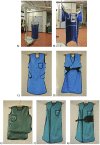Physical strain while wearing personal radiation protection systems in interventional radiology
- PMID: 35862403
- PMCID: PMC9302834
- DOI: 10.1371/journal.pone.0271664
Physical strain while wearing personal radiation protection systems in interventional radiology
Abstract
Objectives: Multiple studies show orthopedic health problems for medical staff due to wearing radiation protection aprons. The aim of this study was to evaluate the weight pressure on the shoulder as a marker of physical strain caused by different radiation-protection devices.
Methods: For the weight pressure measurement, a pressure sensor (OMD-30-SE-100N, OptoForce, Budapest, Hungary) placed on the left and right shoulder was used. Wearing different radiation protection systems the force measurement system was used to quantify the weight pressure. Measurements were acquired in still standing position and during various movements.
Results: A mean significant decreasing weight pressure on the shoulder between 74% and 84% (p<0.001) was measured, when the free-hanging radiation protection system was used in comparison to one-piece and two-piece radiation protection aprons and coats. Using two-piece radiation protection aprons, the weight pressure was significantly lower than that of one-piece radiation protection coats. If a belt was used for the one-piece radiation protection coat, the weight pressure on the shoulder was reduced by 32.5% (p = 0.003). For a two-piece radiation protection apron and a one-piece radiation protection coat (with and without belt) a significant different weight pressure distribution between the right and left shoulder could be measured.
Conclusions: The free-hanging radiation protection system showed a significant lower weight pressure in comparison to the other radiation protection devices. Apart from this, use of a two-piece radiation protection apron or addition of a belt to a radiation protection coat proved to be further effective options to reduce weight pressure.
Conflict of interest statement
The authors have declared that no competing interests exist.
Figures




Similar articles
-
Efficiency in radiation protection of a novel exoskeleton-based interventional radiology apron and correlation with conventional aprons.Eur J Radiol. 2025 Mar;184:111946. doi: 10.1016/j.ejrad.2025.111946. Epub 2025 Jan 31. Eur J Radiol. 2025. PMID: 39946813
-
Modified design of x-ray protective clothing to enhance radiation protection for interventional radiologists.Med Phys. 2023 Jun;50(6):3825-3832. doi: 10.1002/mp.16309. Epub 2023 Mar 1. Med Phys. 2023. PMID: 36794321
-
X-Ray Protective Aprons Re-Evaluated.Rofo. 2023 Mar;195(3):234-243. doi: 10.1055/a-1994-7332. Epub 2023 Feb 16. Rofo. 2023. PMID: 36796379 English, German.
-
Should We Keep the Lead in the Aprons?Tech Vasc Interv Radiol. 2018 Mar;21(1):2-6. doi: 10.1053/j.tvir.2017.12.002. Epub 2017 Dec 15. Tech Vasc Interv Radiol. 2018. PMID: 29471995 Review.
-
Get the Lead off Our Backs!Tech Vasc Interv Radiol. 2018 Mar;21(1):7-15. doi: 10.1053/j.tvir.2017.12.003. Epub 2017 Dec 19. Tech Vasc Interv Radiol. 2018. PMID: 29472000 Review.
References
-
- Klein L.W., Tra Y., Garratt K.N., Powell W., Lopez-Cruz G., Chambers C., et al.. Society for Cardiovascular, Interventions, Occupational health hazards of interventional cardiologists in the current decade: Results of the 2014 SCAI membership survey, Catheter Cardiovasc Interv 86(5) (2015) 913–24. doi: 10.1002/ccd.25927 - DOI - PubMed
-
- Goldstein J.A., Balter S., Cowley M., Hodgson J., Klein L.W., I. Interventional Committee of the Society of Cardiovascular, Occupational hazards of interventional cardiologists: prevalence of orthopedic health problems in contemporary practice, Catheter Cardiovasc Interv 63(4) (2004) 407–11. doi: 10.1002/ccd.20201 - DOI - PubMed
MeSH terms
LinkOut - more resources
Full Text Sources
Medical

